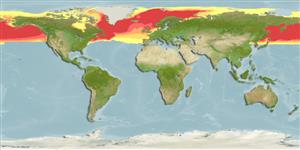Common names from other countries
分类 / Names
俗名 | 同种异名 | Catalog of Fishes(属, 种) | ITIS | CoL | WoRMS | Cloffa
Teleostei >
Osmeriformes (Freshwater smelts) >
Osmeridae (Smelts)
Etymology: Mallotus: Greek for fleecy, derived from mallos = wool, and -otus = a Greek adjectival suffix referring to property; referring to the shape of the scales along the side of breeding males, appearing hairy or fleecy (S.Kullander, pers. Comm.).; villosus: From the Latin 'villosus' meaning hairy - refers to the rough extruded scales on spawning males..
Environment: milieu / climate zone / depth range / distribution range
生态学
海洋; 淡水; 半咸淡水; 溯河洄游 (Ref. 46888); 深度上下限 0 - 725 m (Ref. 58426), usually ? - 200 m (Ref. 96339). 極; 84°N - 37°N, 180°W - 180°E (Ref. 54574)
Circumpolar in the Arctic. North Atlantic: Barents Sea up to Bear Island, in the White and Norwegian seas, off the coast of Greenland up to 74°N and from Hudson Bay in Canada to Gulf of Maine, USA. North Pacific: south to Korea and Juan de Fuca Strait, Canada.
在北極圈的極地附近。 北大西洋: 巴倫支海向上到在白色而挪威的海洋中有島外海的格陵蘭向上到 74 ° N 的海岸與從在加拿大到緬因灣,美國的哈得遜灣。 北太平洋: 南至韓國與胡安 de Fuca 海峽在加拿大。
Length at first maturity / 大小 / 重量 / 年龄
Maturity: Lm 13.3, range 15 - 19 cm
Max length : 20.0 cm TL 雄鱼/尚未辨别雌雄; (Ref. 11626); 25.2 cm TL (female); common length : 15.0 cm TL 雄鱼/尚未辨别雌雄; (Ref. 4645); 最大体重: 52.00 g (Ref. 56475); 最大年龄: 10 年 (Ref. 72498)
背棘 (总数) : 0; 背的软条 (总数) : 10 - 14; 臀棘: 0; 臀鳍软条: 16 - 23; 脊椎骨: 62 - 73. Adipose with long base, about 1.5 times as long as the orbit or longer, outer margin only slightly curved (Ref. 6885). Olive green on dorsal surface, merging into silvery on sides and ventral surface (Ref. 6885).
脂鳍有长的基底, 大约 1.5 倍长于眼窝或者更长的,外缘只些微地弯曲了.(参考文献 6885) 橄榄绿色的在背面上, 合并进入银色的之内在侧边与腹面上.(参考文献 6885)
Oceanic species found in schools (Ref. 2850). Nerito-pelagic (Ref. 58426); however, reported at 1086 m Davis Strait to southern Baffin Bay (Ref. 120413). Adults feed on planktonic crustaceans, copepods, euphausiids, amphipods, marine worms, and small fishes (Ref. 6885, 35388). Mature individuals move inshore in large schools to spawn (Ref. 2850). In the spring large spawning shoals migrate toward the coasts, males usually arrive first. Often entering brackish and freshwater (Ref. 37812). Semelparous (Ref. 51846). Produces 6,000-12,000 adhesive eggs. Females are valued for their roe, males are utilized as fishmeal. Marketed canned and frozen; eaten fried and dried (Ref. 9988). Possibly to 725 m depth (Ref. 6793).
成群出现的大洋性鱼种.(参考文献 2850) 吃浮游性甲壳动物,桡脚类的动物,磷虾,片脚类动物,海洋的蠕虫与小鱼。 (参考文献 6885,35388) 在大群鱼群中向海岸移动产卵.(参考文献 2850) 在春天,大的被产卵的浅滩移动朝向海岸, 雄性通常第一个到达。 时常进入半咸淡水与淡水。 (参考文献 37812) 生产品 6,000-12,000 聚集在一起的卵。 雌性为他们的鱼白被认为有价值的, 雄性被利用制成鱼粉。 在市场上销售罐装及冷冻; 油炸后食用与乾燥的.(参考文献 9988) 可能地对 725 公尺深.(参考文献 6793)
Reproductive strategy: synchronous ovarian organization, determinate fecundity (Ref. 51846). Experimental testing suggests facultative semelparity, with offshore-spawning capelin being absolute semelparous (death of both genders) and beach-spawning capelin being iteroparous irrespective of sex (Ref. 92136). Also Ref. 92150.在北極圈的極地附近。 北大西洋: 巴倫支海向上到在白色而挪威的海洋中有島外海的格陵蘭向上到 74 ° N 的海岸與從在加拿大到緬因灣,美國的哈得遜灣。 北太平洋: 南至韓國與胡安 de Fuca 海峽在加拿大。
Eschmeyer, W.N., E.S. Herald and H. Hammann, 1983. A field guide to Pacific coast fishes of North America. Boston (MA, USA): Houghton Mifflin Company. xii+336 p. (Ref. 2850)
CITES (Ref. 128078)
Not Evaluated
人类利用
渔业: 高经济性
工具
特别资料
下载 XML
网络资源
Estimates based on models
Preferred temperature (Ref.
115969): 0.3 - 7.1, mean 2.7 (based on 956 cells).
Phylogenetic diversity index (Ref.
82804): PD
50 = 1.0000 [Uniqueness, from 0.5 = low to 2.0 = high].
Bayesian length-weight: a=0.00363 (0.00290 - 0.00455), b=3.21 (3.14 - 3.28), in cm Total Length, based on LWR estimates for this species (Ref.
93245).
营养阶层 (Ref.
69278): 3.2 ±0.1 se; based on diet studies.
回复力 (Ref.
120179): 中等的, 族群倍增时间最少 1.4 - 4.4年 (K=0.3-0.5; tm=3; tmax=10; Fec=6,000).
Prior r = 0.62, 95% CL = 0.41 - 0.94, Based on 5 full stock assessments.
Fishing Vulnerability (Ref.
59153): Low to moderate vulnerability (27 of 100).
Climate Vulnerability (Ref.
125649): Low vulnerability (24 of 100).
